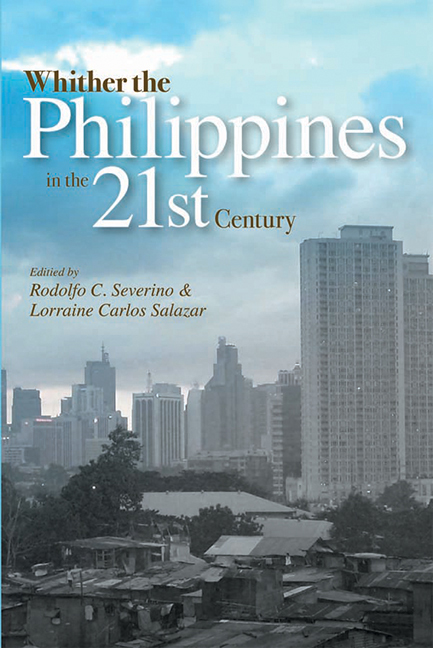Book contents
- Frontmatter
- Contents
- List of Illustrations
- Foreword
- Acknowledgements
- The Contributors
- List of Abbreviations
- Map of Southeast Asia
- 1 The Philippines in Southeast Asia
- 2 From Regime Crisis to System Change
- 3 Proposed Constitutional Reforms for Good Governance and Nation Building
- 4 The Military in Philippine Politics
- 5 Religion and Politics
- 6 The Philippine Press
- 7 Macroeconomic Issues and Challenges
- 8 Investment Climate and Business Opportunities
- 9 Why Does Poverty Persist in the Philippines?
- 10 Diaspora, Remittances, and Poverty
- 11 The Philippine Development Record
- 12 Sancho Panza in Buliok Complex
- 13 The Insurgency That Would Not Go Away
- 14 Whither the Philippines in the 21st Century?
- Index
11 - The Philippine Development Record
Published online by Cambridge University Press: 21 October 2015
- Frontmatter
- Contents
- List of Illustrations
- Foreword
- Acknowledgements
- The Contributors
- List of Abbreviations
- Map of Southeast Asia
- 1 The Philippines in Southeast Asia
- 2 From Regime Crisis to System Change
- 3 Proposed Constitutional Reforms for Good Governance and Nation Building
- 4 The Military in Philippine Politics
- 5 Religion and Politics
- 6 The Philippine Press
- 7 Macroeconomic Issues and Challenges
- 8 Investment Climate and Business Opportunities
- 9 Why Does Poverty Persist in the Philippines?
- 10 Diaspora, Remittances, and Poverty
- 11 The Philippine Development Record
- 12 Sancho Panza in Buliok Complex
- 13 The Insurgency That Would Not Go Away
- 14 Whither the Philippines in the 21st Century?
- Index
Summary
INTRODUCTION
The development economics literature has not been kind to the Philippines. It has been variously described as the “East Asian exception”, “East Asia's Stray Cat” (Vos and Yap 1996), and a “Latin American country in East Asia”. Harvard's Lant Pritchett (2003) was even less complimentary, characterizing the country as a “democratic dud”.
This literature is struggling with the central development puzzle of the Philippines: why has a country with favourable initial conditions — at least relative to its neighbours — grown much slower than almost all of East Asia, particularly since 1980? In particular, the country commenced with a decisive advantage in educational spread and quality. It also inherited a set of functioning public institutions and a constitution, without the trauma of a protracted independence struggle or civil war. Moreover, although this observation is unpopular in certain circles, the Philippines had what many countries are now queuing up for — a free trade agreement with the United States.
The East Asian context is at once both central to the story and somewhat misleading. It is central in the sense that other countries, mainly in the neighbourhood, and some quite similar, have managed to grow very fast. The comparison with Thailand is particularly pertinent. The two countries share much in common — similar population size, land area, resource base, economic structure, movements in their terms of trade, and of course location. Yet Thailand, which was significantly poorer in the 1950s, overtook the Philippines in the early 1980s, and just prior to the recent Asian crisis its per capita income was almost twice higher. If ever there were a case of non-identical twins, this would be it. Thus, more generally, the international environment cannot hold the key to the puzzle, unless (implausibly in our view) one wants to argue that there are aspects of this environment specifically inimical to Philippine economic development interests.
Conversely, it might be argued that these countries are all “exceptions”, and that the Philippine record looks deficient partly because of the company it keeps. In fact, as Felipe Medalla often reminds us, the country's performance is broadly similar to that of the developing world as a whole.
- Type
- Chapter
- Information
- Whither the Philippines in the 21st Century? , pp. 246 - 276Publisher: ISEAS–Yusof Ishak InstitutePrint publication year: 2007

